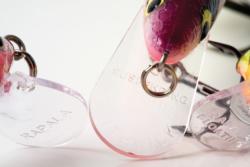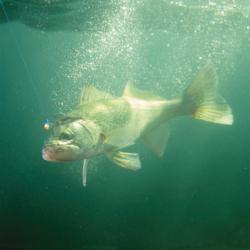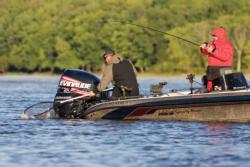Better stickbait techniques for walleyes
These dead-ringer baitfish imitations offer flexibility and simplicity for catching trophy walleyes

Of all the Julys in his walleye-fishing lifetime, 40-year-old Wal-Mart FLW Walleye Tour tournament pro Duane TenCate of Sioux Falls, S.D., remembers one July in particular. He was prefishing for a tournament on Lake Erie, about seven miles out from Sandusky, Ohio. “That’s when I caught my biggest walleye on a stickbait,” he said. “She went 13 pounds, 9 ounces. I remember it like it was yesterday. I was using a Texas red Reef Runner.”
Likewise, FLW Walleye Tour pro Terry Wilson of Powell, Wyo., remembers his biggest walleye on a stickbait, also from Lake Erie. “A 10 1/2-pounder,” he recalled, “in mid-April of 2003. I was using a firetiger Husky Jerk.”
Reef Runners. Frenzy Firestick Minnows Husky Jerks. Thundersticks. Rattlin’ Rogues. All are beloved members of the genus stickbait. They’ve proven their worth time after time by delivering big fish in tough, competitive, tournament-fishing situations. The question is why are these baits so effective for catching big walleyes, and what do the pros know about using them the rest of us don’t?
Match the hatch
In fly-fishing circles, “matching the hatch” means selecting flies that closely resemble what’s hatching in the water at the time you’re fishing. The theory is, the more the fly looks like natural forage, the more apt fish are to hit it without suspicion. It’s not a term often applied to modern-day walleye fishing. Yet, one of the most enduring attributes stickbaits offer is their uncanny ability to look a lot like herring, smelt and alewives.
TenCate is convinced stickbaits are one of the best things going for “match the hatch” walleye fishing.
“Lake Erie’s a good example,” he explained. “In early spring and summer, the water has warmed up and the alewives and smelt, the longer profile baitfish, are up top. By trolling stickbaits, we’re mimicking that. For matching bigger baitfish, stickbaits are the way to go.”
Terry Wilson has been fishing the FLW Walleye Tour since its inception, and has also fished the PWT and local Wyoming, Montana and Kansas circuits. He agrees with TenCate.
“Successful fishing means knowing what baitfish are predominant in the water you’re fishing,” he said. “If it’s smelt, use a stickbait, and match the hatch. The longer profiles of the minnow baits are perfect, whether you’re trolling, using leadcore or casting and retrieving. For me, I use Husky Jerks, tons of Rip Sticks and the Storm Thunderstick. They just match up so well.”
Warming weather
As spring comes on and water temperatures rise, TenCate is particularly fond of deep-diving Reef Runner stickbaits. “In the summer months, I like the bigger diving bills for the wider, faster wobble. The fish are becoming more aggressive, so you can use a more active bait,” he said.
Even later in summer, TenCate sticks with his stickbaits. “Oahe is another good example,” he said of the Missouri River impoundment. “There’s a good smelt base there. When the smelt move a little deeper, in June and July, the walleyes are down there with them, especially in that 37- to 40-foot depth. There’s not a lot of light penetration at that depth, so the action of those stickbaits really helps trigger the bites. At times like that, a stickbait is better than a Shad Rap, which has a tighter wobble.”
Stickbaits offer a lot of flexibility, since they can be presented a lot of different ways, ranging from casting and retrieving, to flatlining and leadcore trolling.
One of TenCate’s favorite methods is casting stickbaits parallel to shore. “For spawning walleyes, especially, I like to cast Smithwick Rattlin’ Rogues,” he said. “I’ve caught fish in as little as a foot of water using a slow, jerkbait-type retrieve. Retrieve it three feet, then pause. Give the fish a long time to see it.”
Wilson takes his stickbait work one step further, using them for night assaults on river systems, even in the bitterly cold months of January and February. “That’s my favorite technique for night fishing,” he said. “It’s almost like jerkbait fishing for bass, right on the surface. Walleyes will inhale a stickbait right off the top. You don’t usually think of walleyes as top feeders. But they will. It’s a smashing hit at night.”
What the Wyoming pro does is fish behind deep holes up close to shore, letting the current pull his stickbait down. “We move around a lot, looking for the holes and the fish. Then I’ll throw parallel to shore and let the current take it down. I’ll use a real erratic retrieve. Straight and slow doesn’t work. It’s more like a jerk-jerk-pause, and the closer to the surface, the better. Sometimes they’ll hit it right near the shore, and other times as you’re bringing it up close to the boat. I’m sure they’re following it, and when you pick it up, they’ll slam it.”
For this heart-pounding presentation, Wilson prefers Thundersticks in blue-silver and black-silver. “You want something that throws a shadow,” he said. “You want that longer, bigger profile that looks like a baitfish.”
Wilson also likes leadcore trolling with stickbaits. “I do more leadcore trolling with stickbaits than long-lining them,” he said. “What dictates it all is first looking for the baitfish and where they are located. You’ve got to see those arches on your screen. Then start playing with the varying lengths of leadcore. I try to stay above the fish.”
When he uses stickbaits, TenCate believes in the gospel according to “Precision Trolling,” the fantastically popular trolling how-to book by Mark Romanack. “I use Mark’s book, so I know if I’ve got 30 feet out, I’m down 7 feet,” TenCate said. “Using planer boards, I can set up my stickbaits exactly, every time, with one stick at 30 feet one at 45 feet, one at 60 feet and one at 80 feet.”
Choosing colors and customizing baits
TenCate believes the environment you’re fishing should dictate stickbait color choices. “So much of it depends on water clarity and what we have in the sky – whether it’s overcast or clear,” he explained. “On a clear day with clear water, go with metallic colors, with a lot of flash. If it’s dingy and cloudy, go to darker oranges and browns.” Some of TenCate’s favorite colors include clown, chartreuse-white and a color that he customizes to a kind of pink-white. He also favors purple demon  (red-purple) from Reef Runner.
(red-purple) from Reef Runner.
For Wilson, color isn’t much of a factor for his night “topwater” fishing.
“It doesn’t matter then,” he said. “But in the daytime, I mark my stickbaits up with red magic markers, to give them a bleeding effect, right down the side.” Wilson favors firetiger, clown, blue-silver and black-silver, and Husky Jerks in glass minnow. For Thundersticks, he likes metallic rainbow.
Like TenCate, Wilson looks at water clarity during the day. “For stained water, I’ll use firetiger, chartreause, clown and gold. In super clear water, I’ll use brighter, shinier colors, like chrome, rainbow trout – any colors with lots of flash. I want a walleye to see the colors of the bait, and the challenge is to figure out what stands out, what they can see best.” On a typical day, Wilson said he may use as many as eight different stickbait colors across all kinds of different depth variations.
Neither pro does much more customizing. “You’ve got to tune it,” TenCate said, “or you’ll never know what depth it’s at. But I don’t do a lot of painting or customizing. What I will do is put a red treble hook up front, to represent some gill bleeding, kind of a wounded bait situation that might trigger one or two extra bites.”
Suspending qualities
Wilson doesn’t experiment much with his baits when it comes to sinking and suspending properties. If he wants a suspending bait, he prefers a Husky Jerk. But TenCate plays with this variable, using suspending strips or dots. “You’ve got to play with them quite a bit,” he says, “especially when you’re trolling.”
A good example, TenCate points out, is early spring fishing: “The walleyes are usually high in the water  column then, so we’re using more shallow-diving stickbaits, and trolling very, very slow, like .8 to 1 mph. I do a lot of S-turning, and adjust speeds up and down. With neutral buoyancy baits, or baits that are weighted just right, the baits will stall. If they rise or fall, sometimes walleyes won’t hit them. But if they can stall just perfectly, so they’re just sitting there during a portion of that turn, that’s when you get hit.”
column then, so we’re using more shallow-diving stickbaits, and trolling very, very slow, like .8 to 1 mph. I do a lot of S-turning, and adjust speeds up and down. With neutral buoyancy baits, or baits that are weighted just right, the baits will stall. If they rise or fall, sometimes walleyes won’t hit them. But if they can stall just perfectly, so they’re just sitting there during a portion of that turn, that’s when you get hit.”
Wilson doesn’t do much customizing weight-wise: “I just tune ’em and go. I don’t play with suspending weights. I probably should, but I’ll color them a little and be good to go. If I want a different suspending quality, I just use a different stickbait.”
Line choices
As with crankbaits, the kind of line used with a stickbait can have more impact on the success or failure of your venture than the length and action of your rod or the casting and fish-fighting qualities of your reel. For TenCate, he keeps it simple, using 10-pound Berkley XT mono whenever possible. “The XT has the strength plus the ability to stretch for bigger walleyes,” he said.
But there are times, he admits, when a superline is indispensable.
“This past year we were at Mobridge (S.D.) for an event. The walleyes were at 34 to 37 feet. With the XT, I could get to 27 feet. But with 4-10 superline (4-pound-test diameter, 10-pound-test strength), I got to 34 to 37 feet with a Reef Runner. There’s always a point of diminishing return where the bait won’t pull down any deeper. But with that thinner diameter, you can get much deeper.”
For his part, Wilson trolls almost exclusively with superlines. “I like FireLine and Power Pro, in 14- and 15-pound test (6-14 and 8-15). “Some people don’t like the no-stretch. But I let the fishing rod be the shock absorber.” Wilson relies on St. Croix’s Wild River 10 1-2-foot rods. “Those are my shock absorbers,” he emphasizes.
Knots, snaps and tuning
Both pros use Palomar knots affixed to cross locks. “Some people tie directly,” TenCate said. “But if you use a cross lock, you let the O-ring do the work and you get a better wobble.” Wilson does the same, and points out it’s quicker to change baits.
Both pros are absolutely adamant about the importance of tuning a stickbait much the same as you would a crankbait. “Make sure to tune every stickbait,” TenCate said.
Fishing three-way stickbaits
The 2005 Wal-Mart FLW Walleye Tour Angler of the Year, Nick Johnson is a big fan of floating Rapala stickbaits on three-way rigs. “I’ll pull three-ways with a stickbait from early, early spring all the way into June on rivers,” he said.
To rig up, the pro ties on a three-way swivel, then a dropper line to a bell sinker weighing from 1 to 5 ounces. He then ties on a five- to six-foot leader and uses a floating Rapala.
“The weight depends on depth and current conditions,” Johnson said. “Trolling speed depends on the attitude of the fish. Some days you’re barely moving; it’s not a fast presentation at all. The important thing is to keep that sinker right on the bottom, and keep the line at a 45-degree angle. With this rig you can cover a bunch of different depths, from 4 feet to 12, to 18, even 20 feet. You’re sliding down the edges, working cross-current, going up and down the breaks…and you’re studying your electronics, looking for fish arches.”
For color, Johnson isn’t all that picky. “With this three-way presentation, just about any color will work. I’ve used firetiger, bright chartreuse, even vampire color (black on top, chrome on side). Blue-white and blue-silver are good, too, especially in muddy water. But if I’m going to work a winter hole, like 19 to 35 feet deep, I like a firetiger.”
Johnson customizes his stickbaits quite a bit. “I use a red hook on the front, and I use an air brush occasionally to touch them up. I like to put more red around the gills, or a strip of chartreuse down the sides, or paint a red belly.”
Johnson also adjusts the eyelets on his floating Rapalas. “Some days you want a tight wiggle, which is what a floating Rapala has. But on other days I want a wider wobble. So I take the eyelet with pliers and flatten it into an egg shape, and then bend it down toward the bill. It gives it a crazier, erratic wobble. I can make a floating Rapala work like a Rogue this way.”
